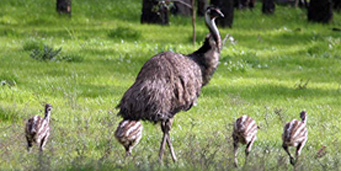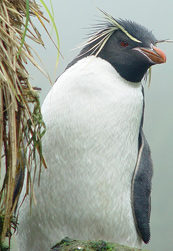
Non-Flying Birds | Birds of Prey | Extinct Birds | Waterfowl

Common Name: Emu
Other Common Names: none listed
Scientific Name: Dromaius novaehollandiae (Full Taxonomy)
Group: Ratite
Description
Emu stand from 5 to 6 feet in height and can weigh up to 150 lbs when mature. Emus normally attain their full height within 12 months. Emus have been known to live in excess of 30 years.
EMU are curious and docile. They are about 10 inches tall at birth, with black and white stripes. As 3 month old chicks, they turn nearly solid black and change into a tan, brown and black mixture as adults, some having a bluish neck. The feathers are downy, with no stiff vein running through the center.
The mature EMU is 5 to 6 feet tall and normally weighs 90 to 140 pounds. Flightless, they are strong runners and reach ground speeds of up to 40 miles per hour in short bursts, covering about nine feet in stride.
Distribution
Emus are absent from heavily populated regions, especially along the east coast. Despite this loss in some areas, Emu numbers may have increased since European settlement. The provision of water for domestic stock, together with the Emu's ability to reproduce rapidly, has favoured its survival. It is estimated that the Emu population is 625,000-725,000, with 100,000-200,000 in Western Australia and the majority of remaining populations in New South Wales and Queensland.
Habitat
The Emu is found only in Australia. It lives throughout most of the continent, ranging from coastal regions to high in the Snowy Mountains. The main habitats are sclerophyll forest and savanna woodland. These birds are rarely found in rainforest or very arid areas. Emus were once found in Tasmania, but were exterminated soon after Europeans arrived. Two dwarf species of emus that lived on Kangaroo Island and King Island also became extinct.
Feeding
Emus eat fruits, seeds, growing shoots of plants, insects, other small animals, and animal droppings.

Rockhopper Penguin
Scientific name: Eudyptes chrysocome
Identification:
Rockhoppers are distinguished from other crested penguins by their smaller size and by having only a thin yellow superscilium. The feather plumes are yellow, not orange as in Macaroni Penguin, and thinner than in the remaining Eudyptes species. The red eye is distinctive.
Southern Rockhopper Penguins differ from their Northern counterparts in having a narrower supercilium and shorter plumes, which reach just over the black throat. Their vocalisations are also different. The Southern Rockhopper actually comprises two subspecies that have been described and can be identified in the field: the nominate form from South America and the Falkland Islands and the eastern subspecies filholi from the New Zealand sub-Antarctic islands. The eastern form mainly differs from the nominate subspecies in having a pink line of fleshy skin along the lower mandible which is black in the nominate subspecies.
Immature birds have only a narrow supercilium and a pale mottled grey chin. Identification of juveniles is difficult. Shape of the supercilium, bill shape, body size and underwing pattern can aid identification. Separation of juvenile Southern and Northern Rockhopper Penguins in the field is probably impossible.
Distribution:
The northern form of the Rockhopper Penguin breeds in cool temperate climates, generally north of the subtropical convergence, with breeding occurring on Tristan da Cunha and Gough Island in the Atlantic Ocean and St. Paul and Amsterdam Islands in the Indian Ocean. The breeding season starts three months earlier (July) than in the southern form. The latter is restricted to the northern sub-Antarctic and has a circumpolar distribution. Breeding colonies are around the Cape Horn area, Falklands, Prince Edward, Marion, Crozet, Kerguelen, Heard, Macquarie, Campbell, Auckland and Antipodes Islands. Campbell Island used to be the eastern stronghold of the species, but the population there has plummeted recently.
Habits:
Breeding colonies are located on rocky slopes and amongst tussocks, sometimes in small caves and amongst crevices. A small nest is build from tussock, peat and pebbles. Nevertheless, most of the first-laid eggs (A-eggs) are lost during incubation. The few chicks that hatch from A-eggs almost invariably die during the first few days of brooding.
Diet:
Crustaceans, in particular euphausids, make up the bulk of food items consumed during most studies of this species. Fish and cephalopods play a minor role, though one study found 53% cephalopods (by weight). Over 90% of the diet (by mass) of Northern Rockhopper Penguins breeding on Gough Island consisted of crustaceans (mainly euphausids). The remaining 10 % was made up of fish and, to a very small extent, squid.
Eudyptes chrysocome

Common Name: Ostrich
Family: Struthionidae: Ostrich
Scientific Name: Struthio camelus
Description
It is a very tall animal with long and flexible throat. This enables it to swallow a number of things including things it cannot digest at all (for instance padlocks, keys etc). Its head is very small. The body is rounded and is covered with brown-coloured feathers. Legs are very long and they have sharp claws which might be dangerous even to humans. They are good swimmers too. Male ostriches can be very dangerous especially during mating season.
Its height is approximately 2.7 metres (9 feet) and weighs about 160 kg (350 lb) whereas the ostrich females are smaller than male ones. This makes ostrich the biggest bird in the world! Moreover it is also the fastest two-legged bird as well. It is able to reach the speed of 75 km per hour (45 mph). Unfortunately it often runs in huge circles so in spite of its speed it is an easy prey sometims. After birth small ostriches grow about 30 cm per month for the first five months. It usually lives in flocks of 5-50 birds.
Distribution Habit
In the open dry grasslands of East Africa, South Africa, and in the Sahara and adjacent Sahel area..
Diet
Ostriches eat various seeds. grasses, bushes and forage on trees. They supplement this diet with animal food such as invertebrates and small vertebrates which they chase by running.
Non-Flying Birds | Birds of Prey | Extinct Birds | Waterfowl
https://www.mbgnet.net/sets/grasslnd/animals/ostrich.htm
https://www.honoluluzoo.org/ostrich.htm
https://www.antarcticconnection.com/antarctic/wildlife/penguins/rockhopper.shtml
https://www.penguins.cl/rockhopper-penguins.htm
https://www.centralpets.com/animals/birds/ratites/rtt4431.html
https://www.gotpetsonline.com/emu/emu-bird/emu-bird.html
https://agonline.com/AgOnLine/emuinfo.htm